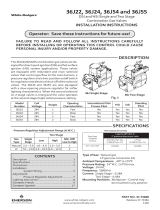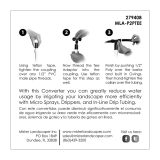
PRECAUTIONS
1. Failure to turn off electric or main gas supply to
heating system could cause personal injury and/
or property damage by shock, gas suffocation, fire,
and/or explosion.
2. Do not use this control on circuits exceeding speci-
fied voltage. Higher voltage will damage the control
and may cause shock or fire hazard.
3. NEVER USE FLAME OR ANY KIND OF SPARK TO
CHECK FOR GAS LEAKS–COULD CAUSE FIRE AND/
OR EXPLOSION.
4. DO NOT USE WIRE JUMPER on pilot systems, such
as standing pilot, proven pilot, or spark-to-pilot
ignition–a fire and/or explosion may result.
If you do not follow these instructions exactly, a fire or explosion may
result, causing property damage, personal injury or loss of life.
5. Do not use a control set for natural gas with LP gas,
or a control set for LP gas with natural gas. Personal
injury and/or property damage, gas suffocation, fire,
and/or explosion may result.
6. Do not use a gas valve which appears
to be damaged. A damaged valve may cause
personal injury and/or property damage due to shock,
gas suffocation, fire and/or explosion. Contact sup-
plier to replace any valve that appears to have been
damaged.
7. Do not use a gas valve that has been in direct contact
with water. Water entering gas valve may result in con-
cealed internal damage to gas valve. Personal injury
and/or property damage, gas suffocation, fire and/or
explosion may result.
2
DO NOT BEGIN INSTALLATION UNTIL YOU READ
THE FOLLOWING PRECAUTIONS.
Properly install gas piping to control.
• Do not remove protective inlet or outlet caps until
ready to connect supply pipe to gas valve.
• Use new supply pipe, properly threaded, reamed,
de-burred, and cleaned.
• Use backup wrench, applied only to provided wrench
flats on inlet boss, when tightening the supply pipe.
Do not grip bracket, solenoid or any other part of
control.
• Do not over-tighten pipe to control (50ft-lbs max.)
• Always install sediment trap in the gas supply line
to prevent contamination of gas valve.
Failure to install properly can cause gas leakage result-
ing in injury due to fire or explosion.
1. Do not short out terminals on gas valve or primary
control to test. Short or incorrect wiring can cause
equipment damage, property damage, and/or per-
sonal injury.
2. This control is not intended for use in locations
where it may come in direct contact with water.
Suitable protection must be provided to shield the
control from exposure to water (dripping, spraying,
rain, etc.).
3. Clean gas piping of contaminants, cutting fluid, or
other chemicals which might react harmfully with
the gas valve components before install.








